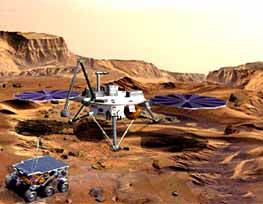| . |  |
. |
Kourou - December 21, 1999 - Satellite communications entered a new era tonight with the successful launch of PanAmSat Corporation's Galaxy XI satellite at the Guiana Space Center. The first of Hughes Space and Communications Company's (HSC) HS 702 satellites, Galaxy XI is the world's largest commercial communications satellite with 64 transponders and more than 10 kilowatts of power at end of life. The satellite was launched on board an Arianespace Ariane 44L rocket at 9:50 p.m. in Kourou (4:50 p.m. PST, 0050 Dec. 22 GMT.) The spacecraft separated from the launch vehicle about 21 minutes later and Galaxy XI's first signals were received about 55 minutes after launch at the ground station in Sydney, Australia, indicating normal operation. "Today's Galaxy XI launch moves PanAmSat one step closer toward operating the largest commercial geostationary satellite network ever deployed," said R. Douglas Kahn, PanAmSat's President and Chief Executive Officer. "PanAmSat will launch six additional Hughes-built satellites in rapid succession. These new satellites, which include two more HS 702 spacecraft, will deliver significantly more power and capacity for PanAmSat's customers around the world." "With today's successful launch, Hughes is leading the way into the next generation of satellite communications," said Tig H. Krekel, President and Chief Executive Officer of Hughes Space and Communications Company. "Galaxy XI represents the best in capacity, performance and cost efficiency, and we extend our thanks and congratulations to PanAmSat." Galaxy XI will provide video distribution, Internet, and telecommunications services in North America and Brazil from an initial orbital position of 99 degrees West longitude, before being migrated to 91 degrees West at a later date. Galaxy XI carries a xenon ion propulsion system (XIPS), which will perform all stationkeeping maneuvers and orbit-raising. Available on the HS 601HP, or high power, and HS 702 satellite models, the increased efficiency possible with XIPS allows for a reduction in propellant mass of up to 90% for a satellite designed for 12 to 15 years operation. Less propellant results in reduced cost for launch, an increase in payload, or an increase in satellite lifetime, or any combination of the above. Galaxy XI is scheduled to be at its initial operating position about 90 days after launch. Galaxy XI, the first HS 702, leverages many of the efficiency-producing technologies inherent in Hughes' other satellite models, and extends these models into more capable and longer-lived revenue-producers for satellite operators. To achieve higher power, the solar array carries dual-junction gallium arsenide solar cells, able to convert nearly 25% of the sun's rays into electrical power, and uses angled reflector panels along both sides of the solar wings to concentrate more sunlight onto those solar cells. Deployable radiators use flexible heat pipes, which make it possible to utilize more of the radiator's surface for heat dissipation.
 Cameron Park - December 20, 1999 -
Cameron Park - December 20, 1999 - In the previous two installments of this series, I discussed the possible causes of the Mars Polar Lander failure, and whether in combination with the MCO failure and others, it indicated that NASA should consider ditching its philosophy of "better faster cheaper". |
|
|
|
|
|
|
|
|
|
|
|
|
|
| The content herein, unless otherwise known to be public domain, are Copyright 1995-2006 - SpaceDaily.AFP and UPI Wire Stories are copyright Agence France-Presse and United Press International. ESA PortalReports are copyright European Space Agency. All NASA sourced material is public domain. Additionalcopyrights may apply in whole or part to other bona fide parties. Advertising does not imply endorsement,agreement or approval of any opinions, statements or information provided by SpaceDaily on any Web page published or hosted by SpaceDaily. Privacy Statement |